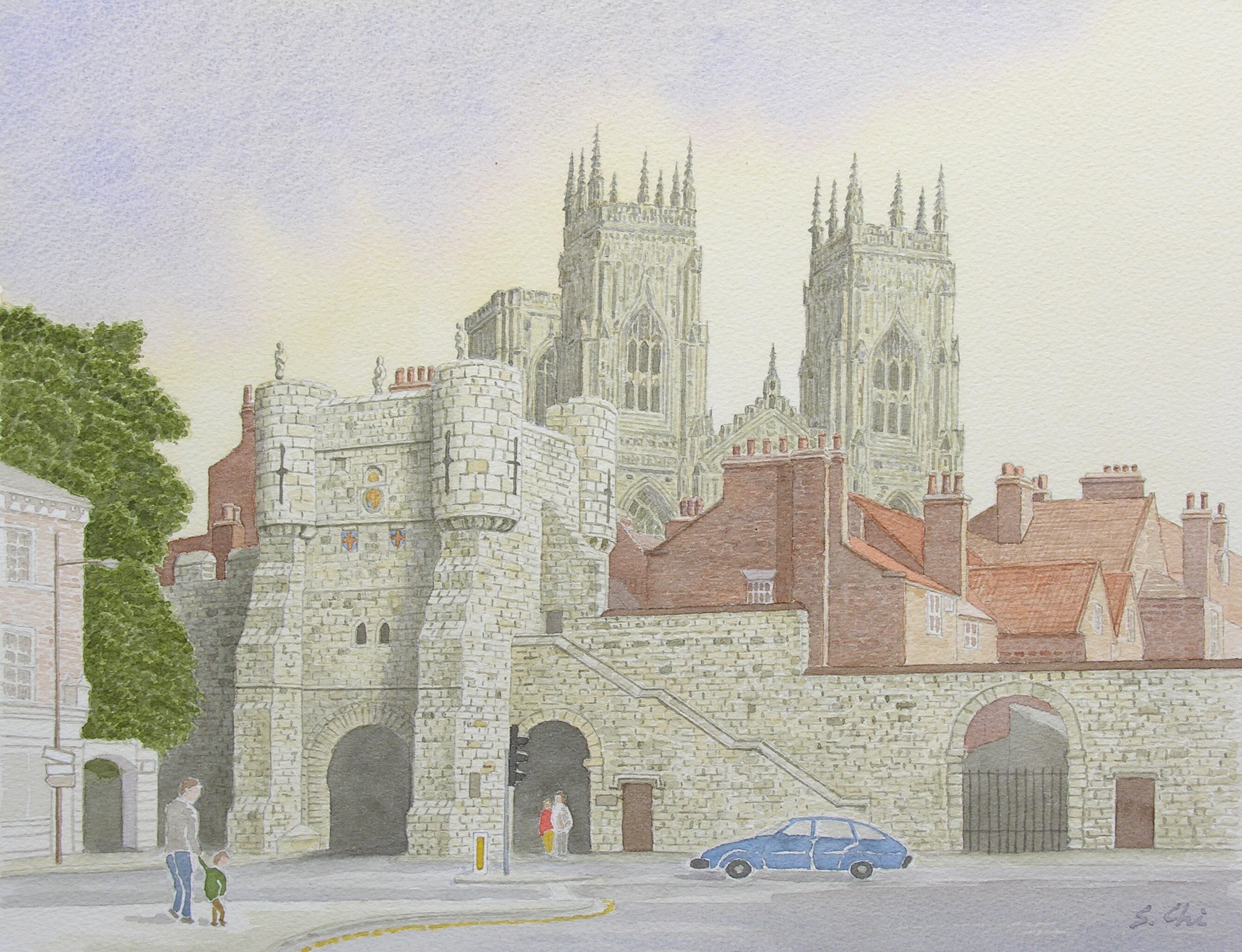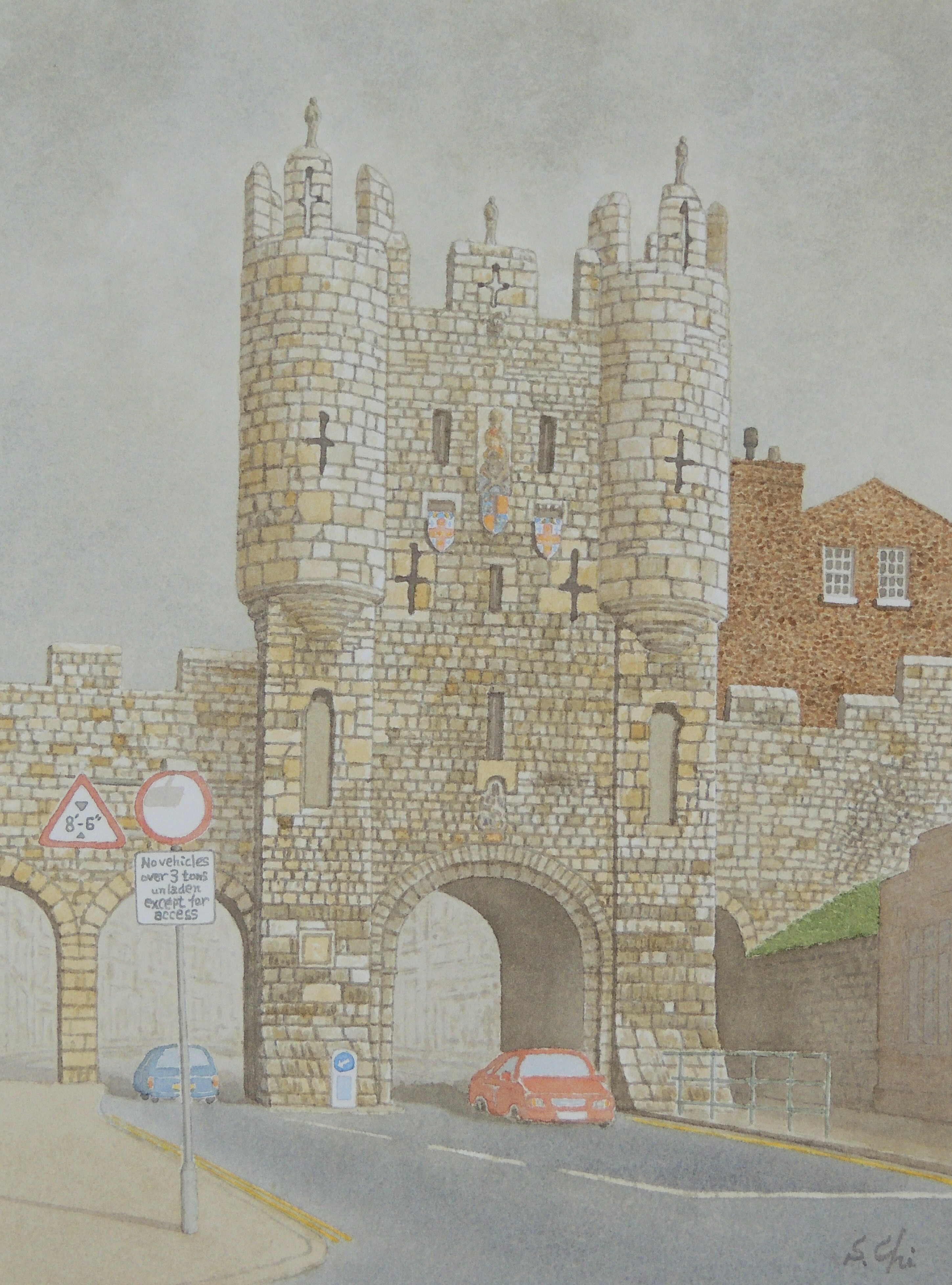
遥かなる わがヨークシャー (Faraway My Yorkshire)
古都ヨーク (York)
17 ブ―サム城門とヨーク大聖堂 (Bootham Bar and York Minster)

ここからは、ヨークとその周辺へ出かけてみたいと思う。
ヨークは、ローマ時代からつづいてきた歴史の町である。中世にはロンドンにつぐ大都会であり、イングランド北部の中心地として、その首都的機能をはたしてきた。また、南のカンタベリーとならぶ、一大宗教都市でもあった。
ジョージ6世(在位1936-52)はヨークを訪れたとき、「ヨークの歴史はイングランドの歴史そのものである」と言ったという。ヨークの歴史は、まさにイングランドの歴史そのものである。市内には、ローマ時代やヴァイキング時代の遺跡から、中世・近世の建物まで、数多く残されている。
ヨークシャーの歴史は、古代にはじまる。かつてイングランドの北部には、ケルト人部族のなかでも強大な勢力を誇っていたブリガンテス族の王国があった。ヨークと、そこから北西へ28kmほど行ったところのバラブリッジの付近には、彼らの一大居住地があったとされている。
紀元60年代にその国に君臨していたのは、女王カルティマンドゥアとその夫で共同統治の王ウェンティウスであった。
60年代後半にローマ軍がこの地にまで進出してくると、ローマ文明にあこがれていた女王は親ローマ政策をとろうとした。だが王は、それに反対だった。すると女王は、夫を武力で追放し、その部下であった男を新たな共同統治の王となした。これにたいして反ローマ勢力は、ウェンティウスのもとに結集した。そして王国は真っ二つに分裂し、内乱に突入していった。
するとそこに、ローマ軍が女王側に加勢して介入し、親ローマ勢力に勝利をもたらすのだった。
しかし数年ごには、ブリガンテス族の王国は完全にローマ軍の支配下におかれ、やがて消滅していった。
紀元71年、ローマ帝国属州ブリタニアの総督クィンタス・ペティリウス・ケリアリスは、南のリンカンに駐留していた第9ヒスパーナ軍団を率いてヨークまで来ると、ここに砦を築き、そこをプリンシピア(軍団本部)を置いた。そしてローマ人は、この地をエブラクムと呼んだ。のちにここには、第6ヴクトゥリクス・ピア・フィディリス軍団が常駐するようになった。
6世紀以降のアングロ・サクソンの時代には、ヨークはイアフォウィックと呼ばれ、七王国*の一つ、ノーサンブリア王国の都となった。
9世紀にイングランドに侵入してきたヴァイキング*の一派であるデ―ン人は、866年ないし867年にイアフォウィックを攻略し、すべてを焼き払った。そして、そこに彼らの新しい交易都市をつくり、そこをヨーヴィックと呼んだ。その呼び名が変化し、現在の地名「ヨーク」になったとされている。
征服王ウィリアム1世は、1066年10月14日のヘイスティングズの戦いでイングランド王ハロルド2世を破ると、翌年にイングランド北部の征服に乗りだした。そしてヨークを北部支配の要(かなめ)と見ると、そこを流れるウーズ川の両岸に二つの城を築き、睨みをきかせた。
13世紀には、城と町をとりかこむ強固な城壁が築かれた。
ヨークの中心部でかつてローマ軍の第6軍団の本部があったところには、いまヨーク大聖堂が立っている。
その起源は七王国の時代にまでさかのぼり、ノーサンブリアの王エドウィンが627年に建てた木造の小さな教会にあるとされている。その教会はその後、石造りで建て替えられた。しかし、南の隣国マーシアの異教徒の王ペンダとの戦いでエドウィンが敗れてからは、ノーサンブリアのキリスト教は急速に衰退し、彼が建てた教会も荒廃してしまった。
670年ごろ、ヨークの教会は聖ウィルフレッドによって再建された。735年にはカンタベリー大司教区から独立したヨーク大司教座が置かれ、大聖堂となった。それ以来400年間、西ヨーロッパでも屈指の教会として隆盛を極めてきた。
しかしウィリアム1世の征服行がこの地にまでおよんできた1067年に、その戦火で焼失してしまった。
11世紀の終わりごろに、大司教トマス・オヴ・バイユーによって再建がはじまり、12世紀のなかごろには、ノルマン様式の大聖堂が完成していた。いまの大聖堂の、前身となるものである。
現在のゴシック様式の大聖堂への建て替えが計画されたのは、大司教ウォルター・ドゥ・グレイによってである。工事がはじまったのは1220年であるが、完成したのは、なんと1480年のことであった。大聖堂としてもまたゴシック様式の建物としても、イギリスで最大である。聖堂の東西方向の長さは約160m、南北方向の最大幅は約76mある。そして西側の正面にある対になった塔――ツイン・タワー――の高さは約56m、聖堂の中央にある明り取りの巨大な塔――ランタン・タワー――の高さは、約71mもある。
ヨーク大聖堂(カセドラル)は、ヨーク・ミンスターとも呼ばれる。ミンスターとは、本来は修道院付属の教会堂のことであるが、由緒ある格式の高い教会に特別にあたえられた名称でもある。
ヨーク大聖堂は、国教会のイングランド北部の母教会であり、「ザ・プライメイト・オヴ・イングランド(イングランド首席司祭)」のヨーク大主教座である。
おもしろいことにヨーク大主教(ローマ・カトリック時代の大司教に相当する地位であるが、国教会になってからはこう記される)は、イングランドの首席司祭といっても、地位は国教会で第2位である。
ちなみに第1位は、正式な肩書きが「全イングランド首席司祭」であるカンタベリー大主教。そしてカンタベリー大聖堂は、イングランド南部の母教会であるとともに、全イングランドの母教会でもある。イングランドの前に「全(all)」が付くか付かないかでは、大ちがいなのである。
ところがじつは、ノルマン征服時代までは、ヨーク大司教とカンタベリー大司教は同格であった。それを1072年にイタリア人のカンタベリー大司教ランフランクが、カンタベリーの優位性を主張し、ウィリアム1世の同意をとりつけると、強引にヨーク大司教を下位に置いてしまった。ヨーク側はこれに激怒し、簡単には引き下がらなかった。そしてカンタベリーとの同格を主張しつづけた。
両者の確執はその後もつづき、諍(いさか)いが絶えなかった。1170年のカンタベリー大司教トマス・ベケットの暗殺事件の遠因の一つにもなっている。ヨーク側が不承ながらもカンタベリーの優位性を受け入れたのは、1352年のことである。
ヨークの旧市街をとりかこむ城壁は、「ザ・シティー・ウォール」と呼ばれている。全長は約3・6kmにおよぶ。
その城壁には、「バー(bar)」という城門が6カ所につくられている。そのうちの一つヴィクトリア城門は19世紀につくられたものであるが、ミクルゲイト城門、ブ―サム城門、モンク城門、ウォルムゲイト城門、そしてフィッシャーゲイト城門は、中世につくられたものである。これらの城門は、いまもその時代の雰囲気を色濃くとどめている。見るからに強固そうで、まるで砦のようである。
かつて城門には、敵の侵入を防ぐためのポートカリス(落し格子戸)があった。また城門は、処刑された反逆者の首がさらされるところでもあったという。
リーズからヨークに車でむかい、A1036号線を通ってヨークに入るとき、正面に背の高い城門が見えてくる。ミクルゲイト城門である。上部の両側に張り出したタリット(張り出し小塔)と屋上の狭間胸壁は、近づく者を威圧するように見おろしている。壁にうがたれた矢狭間は、こちらをじっと睨んでいるようである。
このミクルゲイト城門は、旧市街の西側に位置しているが、国王がヨークに入るときに通る御成門とされている。城門には、ヨーク市の紋章と、ヨーク市と縁の深かったプランタジネット王家の紋章が掲げられている。
旧市街の北側にあるブ―サム城門は、四隅にタリットをもち、城門のなかでももっとも強固そうである。たそがれ時などにブ―サム城門越しにヨーク大聖堂を見あげていると、中世のイングランドに迷い込んだような錯覚をおぼえる。ヨークの城門は、まさに中世イングランドへの入口である。

ミクルゲイト城門 (Micklegate Bar)
<New work for this site>
Next, I visit York, the capital of north England from the ancient times
and the England's second most important city next to London in the Middle
ages.
It was a very difficult work for me to select the places of York to pick
up in this book. If I were to put many watercolours and write much about
York in this book, I would have to prepare a plenty of pages for this city,
and I could write another book only about York.
King George VI is said to have mentioned that the history of York is the
history of England.
Learning the history of York required me to learn more about the history
of England as well as that of Yorkshire.
Once in north England there was a kingdom of the powerful Brigantes, the
Celts, which was ruled by Queen Cartimandua and king Ventius. When the
Romans marched into this district, a civic war began over the policy toward
the Romans in the kingdom, because the Queen was in favour of them but
the King was against them. The Queen expelled her husband by force and
assumed one of his men as new King. Anti-Roman factions gathering under
the former King Ventius, the kingdom was divided and plunged into a civil
war. Then the Romans intervened in the war for the Queen and defeated the
objectors to cease the war. But after several years, the kingdom was conquered
by the Romans completely and then disappeared.
Quintus Petillius Cerialis, the Roman Governor of Britannia, led the 9th
Hispana Legion to York from Lincoln in AD 71 and built a fort and stood
the Roman Principia, military headquarters, where York Minster stands now.
They called it Eburacum. Later, the 6th Victrix Pia Fidelis Legion of the
Roman was stationed there.
In the days of the Anglo-Saxons, after the 6th century, York was called
Eoforwic and became the capital of the kingdom of Northumbria.
The Vikings who invaded England, captured and burned down Eoforwic in 866
or 867, and then made it their new trading centre. They ruled this city
until 954 when Eric Bloodaxe, the last Viking king was killed by Eadred,
King of Wessex at the Battle of Stainmore. The Vikings called the city
Jorvik and it is said that this name was changed to York.
William I, the Conqueror, defeated Harold II, King of England at the Battle
of Hastings in 1066. The following year he started to conquer the north
of England. Aware of the strategic importance of York, he built two Norman
castles on each side of the River Ouse.
In the 13th century, the castle of York and the walls surrounding the town
were built.
York Minster stands at the very site of the Roman Principia stood. The
origin of the Minster was a little wooden church built by Edwin, King of
Northumbria in 627.
The building of Minster we can see today commerced in 1220 and finished
in 1480. It is the largest Gothic cathedral and also the largest Gothic
architecture in England. The length of the whole building is 524ft and
the breadth across the transepts from north to south is 249ft. The height
of the twin west towers is 184ft each, and the lantern tower is 234ft high.
York Minster is the Mother Church of the Northern Province of the Church
of England and has the throne of the Archbishop of York.
It is interesting for me that the position of "the Primate of England"
is the second rank of the Church of England.
The Archbishop of Canterbury who is entitled "the Primate of all England " has the supremacy. Lanfranc, the Archbishop of Canterbury,
subordinated York Minster in 1072. Until then two Archbishops had been
equal. York Minster did not yield soon. In 1352 York admitted reluctantly
the supremacy of Canterbury.
The City Walls surrounding the old town of York extend about 2 and qiuarter
miles. They have 6 bars. Five of them, except Victoria Bar, were built
in the Middle Ages. Micklegate Bar, Bootham Bar, Monk Bar and Walmgate
Bar remain the medieval atmosphere in themselves.
When I drove along the A1036 to enter York, I could see the magnificent
view of the bar in front of me. It was Micklegate Bar, which kings passed
through when they entred York.
Micklegate Bar is a tall bar having the turrets and being crowned with
battlements. They are looking down at us and the loopholes are also staring
at us.
The bars of York look evidently so strong like forts. Among them, Bootham
Bar in the north of the walls looks the strongest one, having a turret
at each of four conners.
The Bars were once fortified with portcullises to stop enemies from entering
the city. And the bars were the places where traitor's heads were displayed.
The view of York Minster over Bootham Bar was very romantic. When I looked
up the Minster over it in twilight, I felt as if I had strayed off into
medieval England. The bars of the City Walls of York are the very gates
to invite us to the world of the Middle Ages.
*七王国 (Heptarchy) 6世紀から10世紀の終わりまでイングランドにあった七つの王国のこと。5世紀の中頃からブリテン島に侵入したアングロ・サクソン人は、部族ごとに各地にいくつもの小王国をつくっていった。それらの王国は離合集散を繰り返すなかで、6世紀頃から、イングランド南部のケント(Kent)、サセックス(Sussex)、エセックス(Essex)、東部のイースト・アングリア(East Anglia)、北部のノーサンブリア(Northumbria)、中部のマーシア(Mercia)、そして南西部のウェセックス(Wessex)の七つの王国を中心にまとまっていった。9世紀にウェセックスの王エグバート(Egbert)がイングランドの覇権を握ったが、実質的にイングランドが統一されたのは、10世紀のエゼルスタン(AEthelstan)の時代。その間には、ヴァイキングであるデ―ン人に侵略され、イングランドの半分以上を支配されたこともあった。
*ヴァイキング (the Vikings) 8世紀末から11世紀中頃までヨーロッパの各地に侵入しては掠奪行為を働いた、北欧出身の海賊の総称。イギリスには8世紀の末頃から現れ、9世紀の中頃からは集団で侵入し、定住するようになった。現在のデンマークを出身地として北海を渡ってきたデ―ン人(the Danes)と、ノルウェーを出身地としてブリテン島北部やアイルランド、マン島を経由して侵入してきたノース人(the Norse, the Norsemen)の2系統に分けられる。彼らは各地で先住のアングロ・サクソン人と死闘をくりかえし、一時はイングランドの半分以上を実効支配したこともあった。1016年にはデンマークのカヌート(Canute)がデ―ン王朝を樹立してイングランド全土を支配した。この王朝は、1042年までつづいた。